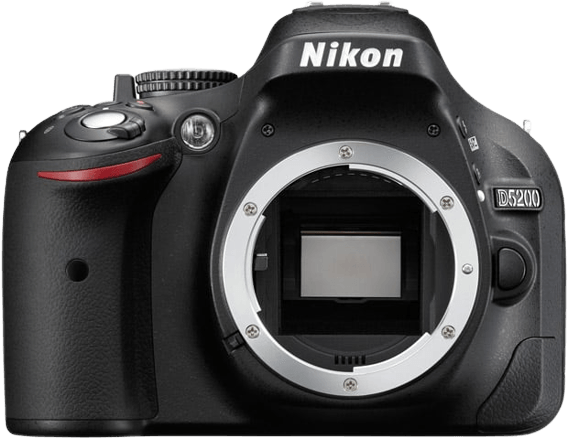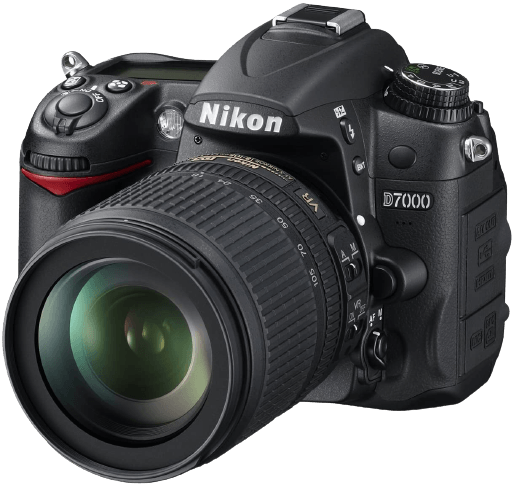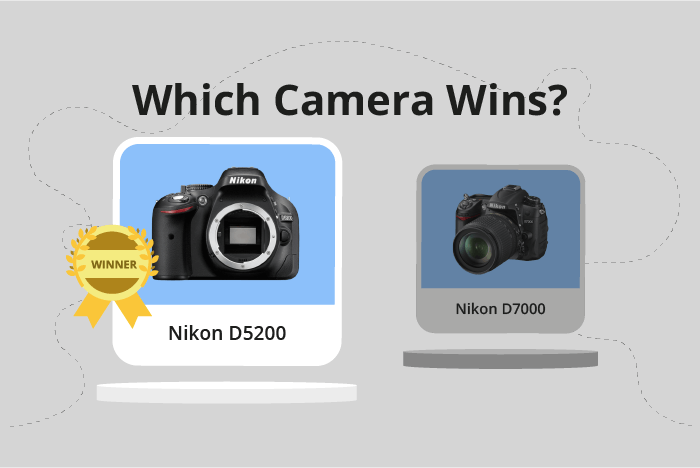Nikon D5200 vs D7000 Comparison
Nikon D5200

Nikon D7000

The Nikon D5200 and Nikon D7000 cameras share many similarities. They are both DSLR cameras, released in 2012 and 2010 respectively. The D5200 is lighter and slightly smaller, measuring 129 x 98 x 78mm and weighing 555g, making it more portable than the D7000, which measures 132 x 105 x 77mm and weighs 780g.
While the D5200 offers more affordability and portability, the D7000 still holds its ground as a reliable DSLR camera. Ultimately, the choice between these two cameras depends on the user’s preferences and priorities in terms of price, size, and weight.
Nikon D5200 vs D7000 Overview and Optics
The Nikon D5200 is the winner in the optics comparison, scoring 65/100, while the Nikon D7000 scores 55/100. Both cameras share some common specifications, such as having a CMOS sensor, APS-C sensor size, Nikon F lens mount, and no image stabilization.
The D5200 outperforms the D7000 in several aspects. With 24.1 megapixels, it has a higher resolution than the D7000’s 16.2 megapixels, allowing for more detailed and sharper images. The D5200 also has a more advanced processor, the Expeed 3, which results in faster image processing and better image quality. Additionally, the D5200 has a higher DXOMARK score for the sensor at 84, compared to the D7000’s score of 80. This means the D5200’s sensor performs better in terms of color depth, dynamic range, and low-light performance.
On the other hand, the D7000 has a faster shooting speed of 6 frames per second compared to the D5200’s 5 frames per second. This can be advantageous for capturing fast action or sports photography. However, this advantage is not enough to outweigh the D5200’s superior optics performance.
In comparing the optics of the Nikon D5200 and D7000, it is clear that the D5200 is the superior choice due to its higher resolution, better processor, and improved sensor performance. While the D7000 has a slightly faster shooting speed, the overall optics performance of the D5200 makes it a better option for photographers seeking high-quality images.
Nikon D5200 vs D7000 Video Performance
The Nikon D5200 emerges as the winner in video capabilities with a score of 70/100, while the Nikon D7000 trails behind with a score of 57/100. Both cameras share common features such as Full HD video recording with a maximum resolution of 1920 x 1080 pixels and built-in time-lapse functionality.
The D5200 outshines the D7000 with a higher maximum video frame rate of 60fps, compared to the D7000’s 24fps. This higher frame rate allows the D5200 to capture smoother and more detailed video, especially in fast-paced situations or when recording sports events. The difference of 36fps significantly enhances the overall video quality and user experience.
On the other hand, the Nikon D7000 does not offer any distinct advantages in video capabilities over the D5200. Both cameras have the same maximum video resolution and time-lapse functionality, with the D7000 falling short in terms of maximum video frame rate.
Taking these factors into consideration, it is evident that the Nikon D5200 is a superior choice for video recording due to its higher maximum video frame rate of 60fps. The Nikon D7000, while still offering Full HD video recording and time-lapse functionality, falls short in comparison with its lower video frame rate of 24fps. Therefore, users seeking better video capabilities should opt for the Nikon D5200.
Nikon D5200 vs D7000 Features and Benefits
The Nikon D7000 triumphs over the Nikon D5200 in the features category, boasting a score of 54/100 compared to the D5200’s 41/100. Both cameras share similarities in certain specifications, such as a 3-inch screen size and a screen resolution of 921,000 dots. Additionally, neither camera possesses a touchscreen, GPS, or Bluetooth capabilities.
The D7000 outperforms the D5200 in one crucial aspect: Wi-Fi connectivity. This feature allows users to easily transfer and share photos, making it more convenient and efficient to work with. On the other hand, the D5200 has a flip screen, which the D7000 lacks. This flip screen allows for greater flexibility when shooting from various angles and can be especially useful for capturing self-portraits or recording video content.
While the D7000’s Wi-Fi functionality gives it an edge, the D5200’s flip screen offers its own unique advantage. Depending on the photographer’s needs and preferences, either camera could be considered the better choice. The D7000 is ideal for those who prioritize seamless photo sharing and storage, while the D5200 caters to users who value versatility in composition and framing.
Considering the features of both cameras, the Nikon D7000 takes the lead with its Wi-Fi capability, offering convenience and ease of use for photographers. However, the Nikon D5200’s flip screen should not be overlooked, as it provides a distinct advantage in certain shooting situations. Ultimately, the choice between the two cameras will depend on the individual’s specific needs and preferences.
Nikon D5200 vs D7000 Storage and Battery
The Nikon D7000 outperforms the Nikon D5200 in storage and battery, scoring 79/100 compared to the D5200’s 27/100. Both cameras share similarities in storage, and accept SD, SDHC, and SDXC cards. However, the D5200 only has a single memory card slot. Furtherdifferences emerge in battery performance.
The D7000’s battery life is superior, providing 1050 shots per charge with its EN-EL15 battery, while the D5200 offers 500 shots using the EN-EL14 battery. This significant difference makes the D7000 a better choice for longer photography sessions without needing to replace or recharge the battery.
On the other hand, the D5200 does not have any notable advantages in this category, as neither camera supports USB charging. The clear winner in storage and battery performance is the Nikon D7000, thanks to its longer battery life, which is crucial for photographers who need to capture extended events or work without access to charging facilities.
Nikon D5200 vs D7000 – Our Verdict
Are you still undecided about which camera is right for you? Have a look at these popular comparisons that feature the Nikon D5200 or the Nikon D7000:

